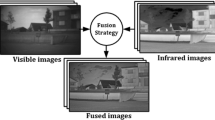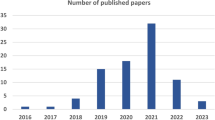Abstract
As signal enhancement technique, image fusion alleviates limitation single sensor in terms to information presentation and enhance visual quality. Extracting affluent features to accurately represent image is crucial for fusion. However, filters via convolutional sparse coding (CSC) have disadvantages of heavy computation cost and low representation. Superior signal representation and low spatial complexity of online convolutional sparse coding are exploited to image fusion to compensate for shortcomings of CSC. The detail and low-frequency components of source images are firstly decomposed using two-layer decomposition. Then each layers use rules to obtain fused components. Finally, fused image can be reconstructed by both high-frequency and low-frequency layers. To verify performance of proposed method, 9 infrared-visible fusion methods and 5 medical fusion methods are used as comparison experiments. The quantitative (\(Q^{ABF}\), \(Q^{E}\), \(Q^{M}\) and \(Q^{P}\)) assessments confirm superiority of method. In addition, qualitative results exhibit powerful information preservation and better visualization.












Similar content being viewed by others
Availability of data and materials
The datasets used or analysed during the current study are available from the corresponding author on reasonable request.
References
Boyd S et al (2011) Distributed optimization and statistical learning via the alternating direction method of multipliers. Now Publishers Inc, New York
Chang X et al (2015) Compound rank-$ k $ projections for bilinear analysis. IEEE Trans Neural Netw Learn Syst 27(7):1502–1513
Heide F et al (2015) Fast and flexible convolutional sparse coding. In: Proceedings of the IEEE conference on computer vision and pattern recognition. pp 5135–5143
Hu Q et al (2021) Multi-modality image fusion combining sparse representation with guidance filtering. Soft Comput 25(6):4393–4407
Kaur M, Singh D (2021) Multi-modality medical image fusion technique using multi-objective differential evolution based deep neural networks. J Ambient Intell Humaniz Comput 12(2):2483–2493
Khare A et al (2021) Shearlet transform based technique for image fusion using median fusion rule. Multimed Tools Appl 80(8):11491–11522
Li S, Yin H (2011) Multimodal image fusion with joint sparsity model. Opt Eng 50(6):067007
Li H et al (2018a) Infrared and visible image fusion using a deep learning framework. In: 2018 24th international conference on pattern recognition (ICPR). IEEE, pp 2705–2710
Li H et al (2018b) Infrared and visible image fusion using latent low-rank representation. arXiv preprint arXiv:1804.08992
Li Z et al (2018c) Rank-constrained spectral clustering with flexible embedding. IEEE Trans Neural Netw Learn Syst 29(12):6073–6082
Li Z et al (2018d) Dynamic affinity graph construction for spectral clustering using multiple features. IEEE Trans Neural Netw Learn Syst 29(12):6323–6332
Li Z et al (2019) Zero-shot event detection via event-adaptive concept relevance mining. Pattern Recognit 88:595–603
Li G et al (2021a) An infrared and visible image fusion method based on multi-scale transformation and norm optimization. Inf Fusion 71:109–129
Li X et al (2021b) Joint image fusion and denoising via three-layer decomposition and sparse representation. Knowl Based Syst 224:107087
Liu Y, Wang Z (2015) Simultaneous image fusion and denoising with adaptive sparse representation. IET Image Process 9(5):347–357
Liu Z et al (2011) Objective assessment of multiresolution image fusion algorithms for context enhancement in night vision: a comparative study. IEEE Trans Pattern Anal Mach Intell 34(1):94–109
Liu Y et al (2015) A general framework for image fusion based on multi-scale transform and sparse representation. Inf Fusion 24:147–164
Liu Y et al (2016) Image fusion with convolutional sparse representation. IEEE Signal Process Lett 23(12):1882–1886
Liu CH et al (2017) Infrared and visible image fusion method based on saliency detection in sparse domain. Infrared Phys Technol 83:94–102
Luo M et al (2021) Reliable shot identification for complex event detection via visual-semantic embedding. Comput Vis Image Underst 213:103300
Ma J et al (2017) Infrared and visible image fusion based on visual saliency map and weighted least square optimization. Infrared Phys Technol 82:8–17
Mairal J et al (2010) Online learning for matrix factorization and sparse coding. J Mach Learn Res 11(1):1–45
Naidu VPS (2011) Image fusion technique using multi-resolution singular value decomposition. Def Sci J 61(5):479
Piella G, Heijmans H (2003) A new quality metric for image fusion. In: Proceedings 2003 international conference on image processing (Cat. No. 03CH37429), vol 3. IEEE, pp III–173
Qu X et al (2008) Image fusion algorithm based on orientation information motivated pulse coupled neural networks. In: 2008 7th World Congress on intelligent control and automation. IEEE, pp 2437–2441
Ren P et al (2020) A comprehensive survey of neural architecture search: challenges and solutions. arXiv preprint arXiv:2006.02903
Ren P et al (2021) A survey of deep active learning. ACM Comput Surv (CSUR) 54(9):1–40
Tan W et al (2020) Multimodal medical image fusion algorithm in the era of big data. Neural Comput Appl 3:1–21
Wang P, Liu B (2008) A novel image fusion metric based on multi-scale analysis. In: 2008 9th international conference on signal processing. IEEE, pp 965–968
Wang X et al (2017) A new infrared and visible image fusion algorithm in nsct domain. In: International conference on intelligent computing. Springer, pp 420–431
Wang Y et al (2018) Scalable online convolutional sparse coding. IEEE Trans Image Process 27(10):4850–4859
Wang L et al (2021) Multimodal medical image fusion based on nonsubsampled shearlet transform and convolutional sparse representation. Multimed Tools Appl 80(30):36401–36421
Wohlberg B (2015) Efficient algorithms for convolutional sparse representations. IEEE Trans Image Process 25(1):301–315
Xu F et al (2013) An enhanced infrared and visible image fusion method based on wavelet transform. In: 2013 5th international conference on intelligent human–machine systems and cybernetics, vol 2. IEEE, pp 453–456
Xydeas CS et al (2000) Objective image fusion performance measure. Electron Lett 36(4):308–309
Yan C et al (2020) Self-weighted robust LDA for multiclass classification with edge classes. ACM Trans Intell Syst Technol (TIST) 12(1):1–19
Yang B, Li S (2014) Visual attention guided image fusion with sparse representation. Optik 125(17):4881–4888
Yin M et al (2018) Medical image fusion with parameter-adaptive pulse coupled neural network in nonsubsampled shearlet transform domain. IEEE Trans Instrum Meas 68(1):49–64
Yu E et al (2018) Adaptive semi-supervised feature selection for cross-modal retrieval. IEEE Trans Multimed 21(5):1276–1288
Zhang C, Yang X (2019) Image fusion based on masked online convolutional dictionary learning with surrogate function approach. In: International conference on intelligent computing, communication and devices. Springer, pp 70–74
Zhao J et al (2007) Performance assessment of combinative pixel-level image fusion based on an absolute feature measurement. Int J Innov Comput Inf Control 3(6):1433–1447
Zhou Z et al (2016a) Perceptual fusion of infrared and visible images through a hybrid multi-scale decomposition with gaussian and bilateral filters. Inf Fusion 30:15–26
Zhou Z et al (2016b) Fusion of infrared and visible images for night-vision context enhancement. Appl Opt 55(23):6480–6490
Acknowledgements
This work was supported by the Sichuan Science and Technology Program (2020YFS0351), the Sichuan University and Luzhou Municipal People’s Government Strategic cooperation projects (2020CDLZ-10) and Intelligent Policing Key Laboratory of Sichuan Province (ZNJW2022ZZMS001).
Funding
This work was supported by the Sichuan Science and Technology Program (2020YFS0351), the Sichuan University and Luzhou Municipal People’s Government Strategic cooperation projects (2020CDLZ-10) and Intelligent Policing Key Laboratory of Sichuan Province (ZNJW2022ZZMS001).
Author information
Authors and Affiliations
Contributions
ZC completed experiment and wrote of paper. ZZ finished language polishing. FZ completed overall framework.
Corresponding author
Ethics declarations
Conflict of interest
The authors declare that they have no conflict of interest.
Ethical approval
This article does not contain any study performed on humans or animals by the authors.
Consent to participate
This article does not contain any study performed on humans or animals by the authors.
Consent for publication
Not applicable
Code availability
Not applicable.
Additional information
Publisher's Note
Springer Nature remains neutral with regard to jurisdictional claims in published maps and institutional affiliations.
Rights and permissions
About this article
Cite this article
Zhang, C., Zhang, Z. & Feng, Z. Image fusion using online convolutional sparse coding. J Ambient Intell Human Comput 14, 13559–13570 (2023). https://doi.org/10.1007/s12652-022-03822-z
Received:
Accepted:
Published:
Issue Date:
DOI: https://doi.org/10.1007/s12652-022-03822-z




